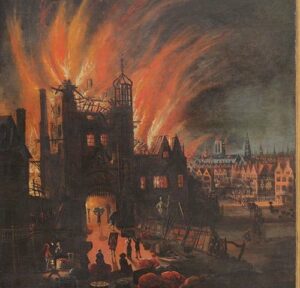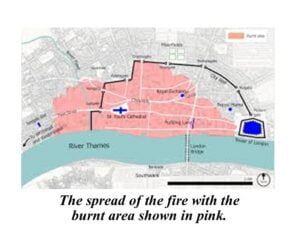
Shortly after midnight on Saturday 1st September 1666, a fire went rogue in Thomas Farriner’s bakery in Pudding Lane in the City of London. Therefore, it means that the date recorded for its start was in fact September 2nd. It spread to nearby houses, nearby lanes, then due to the strong winds, it continued west across the city, creating a most frightening fireball!
The fire burnt all through Sunday, 2nd September, then continued until Thursday that week, devastating the medieval City inside the old Roman city wall. As it started spreading, everyone thought it would keep going and even reach Westminster (the area we today call the West End). Then, more ominously, Charles II’s Palace of Whitehall was at risk. When, fortunately, all of a sudden the wind changed direction and they were saved!
What actions were taken?
Well, everyone knew that the only way to stop a fire spreading was to create a firebreak. To do this they needed to tear down the houses in its path.
Not an easy decision, and the longer it took to make that decision the greater the hold the fire was getting on the city. It had to be made by the Lord Mayor of London, Sir Thomas Bloodworth. It should have been taken immediately. Well, he took his time. Frankly I don’t blame him, it was not easy to immediately order the destruction of people’s homes.
Eventually, on Sunday night, he finally ordered large-scale demolitions, unfortunately the wind had already generated such a firestorm that it defeated the fire break.
Monday
The result was that on Monday the fire travelled into the heart of the city.
This produced a further problem, public order broke down, as rumours spread across the city, that foreigners were starting the fires. You see at this time England was at war, fighting the Second Anglo-Dutch War. This meant that rumours were quickly believed, especially by those who lost their homes, that it was either the French or Dutch who had started it. This resulted in street violence and even public lynching’s of any immigrants the mob could find.
Tuesday
By Tuesday, the fire of London was covering most of the city, it has even destroyed St Paul’s Cathedral. It then jumped across the River Fleet; this is when they started worrying about it reaching Charles II’s palace at Whitehall.
How did they stop it?
 Well, they did stop it, fortunately just before it reached the palace.
Well, they did stop it, fortunately just before it reached the palace.
There were two saving graces:
- The wind changed direction!
- The soldiers at the Tower of London started creating firebreaks with gunpowder. They worked and stopped the fire spreading to the east.
Phew! Yes, it was a close one!
The Damage
Nobody knows how many people were killed. Would you believe that in those days they didn’t record the deaths of poor citizens, so the death toll is unknown. Official figures show only six deaths, it was probably more, but they don’t think it was significantly more.
However, it did create overwhelming social and economic problems.
The aristocracy were strongly encouraged by King Charles II to flee London, which they very quickly did, as he feared there would be violence. He was right to be concerned as it was estimated the Fire of London destroyed the homes of 70,000 people. If you then bear in mind that at the time the total population of the city was only 80,000, you can understand his fears.
How did they rebuild it?
It gave the city many social and economic problems. Many different schemes were put forward but, in the end, they rebuilt it with the same medieval street plan as before the fire. Would you believe that it still exists today?
The biggest result of the Fire of London was the demographic change in the make-up of London, this was the greatest change until the Blitz. This is because many people decided to move to the west of London or even to the villages outside the city. This had an interesting result, they only replaced 9,000 homes even though 13,000 had been destroyed, and by 1674 many were still unoccupied. There was a benefit to those who stayed, they paid less for their leases.
What about the economy?
As you can imagine the London economy was seriously damaged. With so many premises and so much stock destroyed it left the city’s businesses with heavy debts.
It took time, in fact, many merchants decided to leave the city and settle elsewhere. The city’s charitable foundations were seriously affected and had financial losses, largely because the fire killed their rental income. However, the London economy was saved owing to its unique access to shipping routes while continuing as the centre of England’s political and cultural life.
Interestingly, most of the reconstruction was funded privately. However, the responsibility for rebuilding the infrastructure and public buildings, including St. Paul’s Cathedral, fell to the London Corporation, the City’s governing body. It did this by borrowing, at historically low rates from its citizens and outside investors, secured on its’ reputation and future coal tax receipts
A Benefit
Out of every crisis comes a benefit, and this one bought a huge benefit.
You see in the year before, 1665, London was struck by the Great Plague, that is believed to have killed a sixth of its inhabitants. Then along came the Fire of London, which killed the plague. The fire burnt down all that unsanitary housing that bred the rats and their fleas, who had carried the plague across the city. They were no more!
Therefore, the benefit was that the fire killed the plague, and after that London never had another outbreak of plague.
The question is, was the great fire of London a disaster or did it actually save the City?
Isn’t History Fun?
10 questions to discuss:
- What were the initial challenges faced in combating the Great Fire of London, particularly in terms of decision-making and action?
- How did the spread of rumors about foreigners contributing to the fire exacerbate the situation, leading to social unrest?
- Describe the pivotal moments on Monday and Tuesday during the fire’s progression. How did these events escalate the crisis?
- What were the key factors that ultimately halted the spread of the fire, preventing it from reaching Charles II’s palace and further devastating the city?
- Reflecting on the aftermath, what were the uncertainties regarding the death toll, and how did it impact the city’s response and recovery efforts?
- How did King Charles II’s actions influence the response to the fire, particularly in terms of encouraging the aristocracy to flee London?
- Discuss the impact of the Great Fire on London’s demographic makeup and housing infrastructure, including the decision-making process for rebuilding.
- In what ways did the fire affect the London economy, and what measures were taken to mitigate its economic fallout?
- Analyze the role of private funding versus public responsibility in the reconstruction efforts following the Great Fire.
- Evaluate the long-term consequences of the Great Fire, considering both its immediate devastation and its unexpected benefits, such as the eradication of the Great Plague.
To get more information:
https://www.nationalarchives.gov.uk/education/resources/great-plague/
https://www.historic-uk.com/HistoryUK/HistoryofEngland/The-Great-Fire-of-London/
https://www.london-fire.gov.uk/museum/history-and-stories/the-great-fire-of-london/
©Tony Dalton

